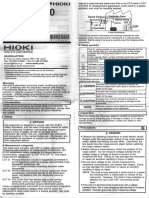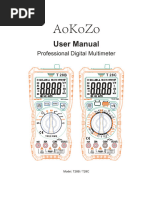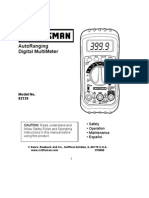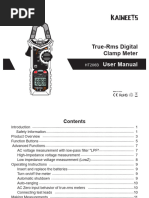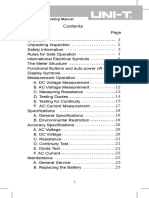VOM Kyorjtsu 2000 2001 E
VOM Kyorjtsu 2000 2001 E
Uploaded by
MmzzPiCopyright:
Available Formats
VOM Kyorjtsu 2000 2001 E
VOM Kyorjtsu 2000 2001 E
Uploaded by
MmzzPiOriginal Description:
Copyright
Available Formats
Share this document
Did you find this document useful?
Is this content inappropriate?
Copyright:
Available Formats
VOM Kyorjtsu 2000 2001 E
VOM Kyorjtsu 2000 2001 E
Uploaded by
MmzzPiCopyright:
Available Formats
INSTRUCTION MANUAL
WARNING
SAFETY WARNINGS
This instrument has been designed and tested according to IEC Publication 61010:
Safety Requirements for Electronic Measuring Apparatus. This instruction manual
contains warnings and safety rules which must be observed by the user to ensure
safe operation of the instrument and to retain it in safe condition. Therefore, read
through these operating instructions before starting using the instrument.
WARNING
Read through and understand instructions contained in this manual before
starting using the instrument.
Save and keep the manual handy to enable quick reference whenever
necessary.
Be sure to use the instrument only in its intended applications and to follow
measurement procedures described in the manual.
Be sure to understand and follow all safety instructions contained in the manual.
Failure to follow the above instructions may cause injury, damage to the instrument
and/or damage to equipment under test.
The symbol
indicated on the instrument means that the user must refer to related
parts of the manual for safe operation of the instrument. Be sure to carefully read the
instructions following each symbol in this manual.
DANGER is reserved for conditions and actions that are likely to cause serious or fatal
injury.
WARNING is reserved for conditions and actions that can cause serious or fatal injury.
CAUTION is reserved for conditions and actions that can cause minor injury or
instrument damage.
Following symbols are used on the instrument and in the instruction manual.
Attention should be paid to each symbol to ensure your safety.
Refer to the instructions in the manual.
This symbol is marked where the user must refer to the instruction manual so
as not to cause personal injury or instrument damage.
Never attempt to make any measurement, if any abnormal conditions are noted,
such as broken case, cracked test leads and exposed metal parts.
Do not turn the Function Selector Switch while the test leads are connected to the
circuit under test.
Do not install substitute parts or make any modification to the instrument. Return
the instrument to Kyoritsu or your distributor for repair or re-calibration.
Do not try to replace the batteries if the surface of the instrument is wet.
Always disconnect the clamp sensor and the test leads from the circuit under test
and switch off the instrument before opening the battery compartment cover for
battery replacement.
CAUTION
Measurement categories (Over-voltage categories)
To ensure safe operation of measuring instruments, IEC61010 establishes safety
standards for various electrical environments, categorized as CAT to CAT, and called
measurement categories. Higher-numbered categories correspond to electrical
environments with greater momentary energy, so a measuring instrument designed for
CAT environments can endure greater momentary energy than one designed for CAT.
CAT.: Secondary electrical circuits connected to an AC electrical outlet through a
transformer or similar device.
CAT.: Primary electrical circuits of equipment connected to an AC electrical outlet by a
power cord.
CAT.: Primary electrical circuits of the equipment connected directly to the distribution
panel, and feeders from the distribution panel to outlets.
CAT.: The circuit from the service drop to the service entrance, and to the power meter
and primary over-current protection device (distribution panel).
Interior wiring
Indicates an instrument with double or reinforced insulation.
DIGITAL MULTIMETER
WITH
AC/DC CLAMP SENSOR
KEW MATE 2000/2001
KYORITSU ELECTRICAL INSTRUMENTS WORKS, LTD.,
TOKYO, JAPAN
AC/DC Clamp Sensor
Indicates that this instrument can clamp on bare conductors when measuring
a voltage corresponding to the applicable Measurement category, which is
marked next to this symbol
Indicates AC (Alternating Current)
Indicates DC (Direct Current).
Indicates AC and DC.
DANGER
Never make measurement on circuits with a maximum voltage difference of
600VAC/DC or greater between conductors (300VAC/DC or greater between a
conductor and ground).
Do not attempt to make measurement in the presence of flammable gasses.
Otherwise, the use of the instrument may cause sparking, which leads to an
explosion.
Never attempt to use the instrument if its surface or your hand is wet.
Do not exceed the maximum allowable input of measuring ranges.
Never open the battery compartment cover while making measurement.
Never try to make measurement if any abnormal conditions, such as broken
Transformer jaws or case is noted.
The instrument is to be used only in its intended applications or conditions.
Otherwise, safety functions equipped with the instrument doesn
t work, and
instrument damage or serious personal injury may be caused.
Conductor
Test Leads
Adjust a
conductor to
the center of
the arrow.
Correct
Wrong
MODEL2000
MODEL2001
CAT.
CAT.
Transformer
CAT.
Socket
CAT.
PREPARATIONS FOR MEASUREMENT
1Checking battery voltage
Set the Function Selector Switch to any position other than the OFF position.
If the marks on the display is clearly legible without symbol "BATT" showing,
battery voltage is OK. If the display blanks or "BATT" is indicated, replace the
batteries according to section 8: Battery Replacement.
NOTE
When the instrument is left powered on, the auto-power-save function
automatically shut the power off; The display blanks even if the Function
Selector Switch is set to a position other than the OFF position in this state.
To power on the instrument, turn the Function Selector Switch or press the
Data Hold Button. If the display still blanks, the batteries are exhausted.
Replace the batteries.
2Make sure that the Function Selector Switch is set to the appropriate range.
Also make sure that data hold function is not enabled. If inappropriate range is
selected, desired measurement cannot be made.
6-1-1 DC Current Measurement
(1)The Function Selector Swith to the " A" position.
("DC" and "AUTO" marks are shown on the top of the display.)
(2)Turn the 0(Zero) ADJ knob to set the reading of the multimeter to zero. (If this
zero adjustment is made incorrectly, measurement errors will result.)
(3)Adjust one of the conductors to the center of the clamp sensor's arrow.
( When the position of the conductor is not at the center of the arrow, the error
occurs.)
Measured value is shown on the display.
Note: When current flows from the upside to the underside of the instrument, the
polarity of the reading is positive (+). Otherwise, the polarity of the reading is
negative (-).
6-1-2 AC Current Measurement
(1)Set the Function Selector Switch to " A."
("AC" and "AUTO" marks are shown on the top of the LCD.)
(2)Adjust one of the conductors to the center of the clamp sensor's arrow.
( When the position of the conductor is not at the center of the arrow, the error
occurs.)
Measured value is shown on the display.
Note: Unlike DC current measurement, zero adjustment is not necessary. There is
not polarity indication either.
FEATURES
Permits AC/DC current measurement up to 60A using a clamp sensor that comes
standard with the instrument
Clamp sensor for ease of use in crowded cable areas and other tight places
Permits current measurement with an open current-clamp sensor that does not
require opening and closing operations by the user
Auto-power-save function
Buzzer for easy continuity checking
Data hold function to freeze the readings
LCD with a 3400 count full scale bar graph
Shock absorbing holster for ease of storage
Designed to international safety standard IEC61010-1: over-voltage category CAT.,
300V and pollution degree 2.
(1)Set the Function Selector Switch to " ."
(2)Check that the display shows over-range. Short the test leads and check that
the buzzer beeps and the display reads zero.
(3)Connect the test leads to the circuit under test. Measured resistance value is
shown on the display. When the measured value is below about 30, the
buzzer beeps.
Note: When the test leads are shorted, the display may read a small resistance
value. This is the resistance of the test leads.
If there is an open in either of the test leads, "OL" is shown on the display.
On the 340 range, " " is shown on the left side of the LCD.
6-4 Frequency Measurement
In order to avoid possible shock hazard, never make measurement on circuits
with a maximum voltage difference of 600VAC/DC or greater between
conductors (300VAC/DC or greater between a conductor and ground).
Do not make measurement with the test leads connected to the circuit under test.
Never make measurement with the battery compartment cover removed.
Do not make current measurement with the test leads connected to the circuit
under test.
Keep your fingers and hands behind the barrier during measurement.
(1)Set the Function Selector Switch to "Hz."
(2)Measuring frequency of current:
Adjust one of the conductors to the center of the clamp sensor's arrow.
Measured value is shown on the display.
Measuring frequency of voltage:
Connect the test leads to the circuit under test. Measured frequency is
shown on the display.
Note: Measuring range of current frequency is 0-10kHz with minimum measurable
input of MODEL2000 15A
Typ/MODEL2001 25A
Typ.
Measuring range of voltage frequency is 0-300kHz with minimum
measurable input of 30V
Typ.
When measuring frequency, do not attach the clamp sensor and the test
leads to the circuit under test simultaneously.
6-1 Current Measurement
DANGER
In order to avoid possible shock hazard, never make measurement on
circuits with a maximum voltage difference of 600VAC/DC or greater
between conductors (300VAC/DC or greater between a conductor and
ground).
Do not make measurement with the test leads connected to the circuit under
test. Never make measurement with the battery compartment cover
removed.
Keep your fingers and hands behind the barrier during measurement.
CAUTION
When handling the clamp sensor, exercise caution not to apply excessive
shocks or vibration to the sensor.
Maximum measurable conductor size is MODEL2000 6mm / MODEL2001
10mm in diameter.
A
Range
60A
100A
DC Current
MODEL
2000
2001
Measuring Range
0-60.0A
0-100.0A
Accuracy
2.0%rdg5dgt(50/60Hz)
2.0%rdg5dgt(50/60Hz)
A
Range
60A
100A
Accuracy
2.0rdg5dgt
2.0rdg5dgt
V Input impedance: 10M
Accuracy
Measuring Range
Range
3.4V
34V
340V
600V
DC Voltage
Measuring Range
0-60.0A
0-100.0A
0-600V
(Auto-ranging)
1.5%rdg5dgt(50-400Hz)
V Input impedance: 10M
Measuring Range
Range
340mV
3.4V
34V
340V
600V
0-600V
(Auto-ranging)
Accuracy
1.5%rdg4dgt
Resistance
Range
340
3.4k
34k
340k
3.4M
34M
Measuring Range
0-33.99M
(Auto-ranging)
Frequency Hz
Measuring Range
Range
0-3.399kHz
Current
3.4kHz-10kHz
(Auto-ranging)
0-3.399kHz
3.4kHz-33.99kHz
Voltage
34kHz-300kHz
(Auto-ranging)
Electromagnetic
compatibility
(IEC 61000-4-3)
Accuracy
1.0%rdg3dgt
Buzzer beeps below 3010
Continuity buzzer works on 340 range
only
5%rdg5dgt
15%rdg5dgt
Operating System
Display
Over Input Indication
Auto-ranging Operation
Sample Rate
Indoor use, Altitude up to 2000m
235, relative humidity 75% or less
(without condensation)
0-40, relative humidity 85% or less
(without condensation)
-20-60, relative humidity 85% or less
(without condensation)
Two 1.5VDC R03 (UM-4) batteries
Approx. 10mA
Shifts to the power-save state about 10 minutes after
the last switch operation
(current consumption: approx. 10A)
Overload Protection
AC/DC current ranges: MODEL2000 AC/DC 72A for
10 seconds
AC/DC current ranges: MODEL2001 AC/DC 120A for
10 seconds
AC/DC voltage ranges: AC/DC 720V for 10 seconds
Resistance ranges: AC/DC 720V for 10 seconds
Frequency ranges: AC/DC 720V for 10 seconds
Withstand Voltage
AC3700V for 1 minute between electrical circuit and
housing case
Insulation Resistance
10M or greater at 1000V between electrical circuit
and housing case
Conductor Size
MODEL2000 Approx. 6mm diameter max.
MODEL2001 Approx. 10mm diameter max.
Dimensions MODEL2000 128(L)87(W)24(D)mm
MODEL2001 128(L)92(W)27(D)mm
Weight
MODEL2000 Approx. 210g
MODEL2001 Approx. 220g
Accessories
Two R03 (UM-4) batteries
Instruction Manual
INSTRUMENT LAYOUT
AC/DC Clamp Sensor
Accuracy
Test Lead
LCD Display
0.1%rdg1dgt
Barrier
Barrier
0.1%rdg1dgt
RF field 1 V/m
ACV/DCV/OHMS/FREQUENCY total accuracy = specified accuracy
ACA/DCA
total accuracy = specified accuracy+5dgt
RF transmitters such as mobile telephones may not be used in
close proximity.
DCA
Zero Adjust
Knob
IEC 61010-1
over-voltage category CAT., 300V, pollution degree 2
over-voltage category CAT., 600V, pollution degree 2
IEC 61010-2-031
IEC 61010-2-032
IEC 61326 (EMC)
Dual integration
Liquid crystal display with maximum reading of 3399
as well as units and annunciators
Bar graph with maximum points of 33
"OL" on the LCD ( ranges only)
Shifts to the next higher range when bar graph
increases to 33 points
Shifts to the next lower range when bar graph
decreases to 3 points
Numeric reading: about 400ms,
bar graph: about 20ms
This function helps to avoid unwanted exhaustion of the batteries because of
leaving the instrument powered on and extend battery life. The instrument
automatically shifts to the power-save state about 10 minutes after the last
Function Selector Switch or other switch operation.
To return to the normal state: Turn the Function Selector Switch or press the
Data Hold Button twice to exit the power-save state and enable measurement
functions.
MODEL2001 MODEL2000
Data Hold Button
Holster
Function Selector Switch
Range Hold Button
Digital Multimeter
Battery Voltage Warning Data Hold
ACDC
Auto Range
Unit
Buzzer
Manual
Range
Bar Graph
DISTRIBUTOR
7-2 Data Hold Function
This is a function to freeze a measured value on the display. Press the Data
Hold Button once to hold the current reading. In this data hold state, the
reading is held even if input varies. "H" and " " marks are shown on the LCD
instead of "AUTO" mark.
To exit the data hold state, press the Data Hold Button again.
7-3 Range Hold Function
The instrument defaults to auto-ranging ("AUTO" is shown on the LCD).
Pressing the Range Hold Button enables manual selection among
measurement ranges" " mark is shown on the LCD instead of "AUTO" mark
Press the Range Hold Button to select a higher range.
To switch from manual range selection to auto-ranging, press down the Range
Hold Button for about one seconds, or turn the Function Selector Switch to
another position before setting it back to the current range.
Kyoritsu reserves the rights to change specifications or
designs described in this manual without notice and without
obligations.
BATTERY REPLACEMENT
WARNING
In order to avoid possible shock hazard, always disconnect the test leads
from the circuit under test and set the Function Selector Switch to the OFF
position before trying to replace the batteries.
DANGER
CAUTION
In order to avoid possible shock hazard, never make measurement on circuits
with a maximum voltage difference of 600VAC/DC or greater between
conductors (300VAC/DC or greater between a conductor and ground).
Do not make measurement with the battery compartment cover removed.
Keep your fingers and hands behind the barrier during measurement.
Do not mix new and old batteries.
Install batteries in the orientation as shown inside the battery compartment,
observing correct polarity.
When the battery voltage warning mark "BATT" is shown on the top left corner
of the LCD, replace the batteries. Note that the display blanks and "BATT"
mark is not shown if the batteries are completely exhausted.
(1)Set the Function Selector Switch to "OFF."
(2)Remove the instrument from the holster.
(3)Loosen the battery-compartment-cover-fixing screw on the lower back of
the instrument.
(4)Replace the batteries with two new R03 (UM-4) 1.5V batteries.
(5)Put the battery compartment cover back in place and tighten the screw.
6-2-1 DC Voltage Measurement
HOW TO MAKE MEASUREMENT
MODEL
2000
2001
Location for use
Accuracy-insured
Temperature and
Humidity Ranges
Operating Temperature
and Humidity Range
Storage Temperature
and Humidity Range
Source
Current Consumption
Power-save Function
6-2 Voltage Measurement
3Install Test Lead to the Holster on the side of body
It is possible to measure with seeing the LCD Display
keep Test Lead installing to the Holster.
AC Current
Safety Standard
DANGER
Wind the lead around the folder.
Measuring Ranges and Accuracy (at 235, relative humidity75% or less)
AC Voltage
Make sure that the Function Selector Switch is set to an appropriate position
before making measurement.
Always make sure to place the test leads in the test lead holder before making
current measurement.
Do not expose the instrument to the direct sun, extreme temperatures or dew fall.
Be sure to set the Function Selector Switch to the "OFF" position after use. When
the instrument will not be used for a long period of time, place it in storage after
removing the batteries.
Use a damp cloth and detergent for cleaning the instrument. Do not use
abrasives or solvents.
Incoming wire
SPECIFICATIONS
(1)Set the Function Selector Switch to " V."
"DC" and "AUTO" marks are shown on the top of the LCD.
(2)Connect the red test lead to the positive (+) side of the circuit under test and
the black test lead to the negative (-) side. Measured voltage value is shown
on the display.
When the connection is reversed, "-" is shown on the display.
6-2-2 AC Voltage Measurement
(1)Set the Function Selector Switch to " V."
"AC" and "AUTO" marks are shown on the LCD.
(2)Connect the test leads to the circuit under test.
Measured voltage value is shown on the display.
6-3 Resistance Measurement
Prohibition
Screw
OTHER FUNCTIONS
Batteries
7-1 Auto-Power-Save Function
DANGER
Never make measurement on circuits that are live.
Never make measurement with the battery compartment cover removed.
Keep your fingers and hands behind the barrier during measurement.
Battery
Compartment
Cover
NOTE
A small amount of current is consumed even in the power-save state. Make
sure to set the Function Selector Switch to the OFF position when the
instrument is not used.
1007
921507C
You might also like
- Instruction Manual: Kyoritsu Electrical Instruments Works, Ltd. Tokyo, JapanNo ratings yetInstruction Manual: Kyoritsu Electrical Instruments Works, Ltd. Tokyo, Japan1 page
- Asim4k0r True Rms 4000 Count Digital Multimeter ManualNo ratings yetAsim4k0r True Rms 4000 Count Digital Multimeter Manual18 pages
- Instruction Manual: Kyoritsu Electrical Instruments Works, LTDNo ratings yetInstruction Manual: Kyoritsu Electrical Instruments Works, LTD24 pages
- Fnirsi-S1: Digital Multimeter Instruction ManualNo ratings yetFnirsi-S1: Digital Multimeter Instruction Manual64 pages
- Ut501b Insulation Resistance Tester ManualNo ratings yetUt501b Insulation Resistance Tester Manual12 pages
- Autoranging Digital Multimeter: Owner'S ManualNo ratings yetAutoranging Digital Multimeter: Owner'S Manual19 pages
- 400amp True RMS AC/DC Clamp Meter: Model EX613No ratings yet400amp True RMS AC/DC Clamp Meter: Model EX61314 pages
- Boat Maintenance Companions: Electrics & Diesel Companions at SeaFrom EverandBoat Maintenance Companions: Electrics & Diesel Companions at SeaNo ratings yet
- Design of Electrical Circuits using Engineering Software ToolsFrom EverandDesign of Electrical Circuits using Engineering Software ToolsNo ratings yet















